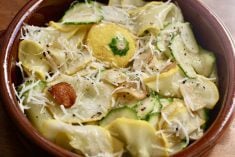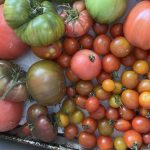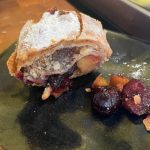Our lives have quieted down after the Christmas and New Year’s season. Everything is back to the usual routine.
On chilly winter mornings there’s nothing more comforting than a warm bowl of oatmeal to get you energized. Not only does this stick-to-your-ribs food make you feel good, it’s good for you.
Oats, a nutrient-dense and high-fibre whole grain, are available in a variety of forms lending to their versatility.
Research shows that eating oats, oat bran and oatmeal helps lower elevated blood cholesterol levels thanks to their special type of soluble fibre called beta-glucan.
Read Also

Glacier FarmMedia writers win agricultural journalism awards
Agricultural reporters with the Glacier FarmMedia family of publications cleaned up at the Canadian Farm Writers Federation awards ceremony late last month in Winnipeg.
This soluble fibre also helps stabilize blood sugar levels by reducing spikes and dips, especially in people with Type 2 diabetes. Large flake and steel-cut oats are low glycemic foods, meaning they’re slowly digested and gradually released as sugar into the bloodstream.
In addition to their high soluble fibre content, oats are also a good source of vitamin B1 (thiamin), vitamin B2 (riboflavin) and vitamin E.
Varieties: All forms of oats are processed to some extent to make them more palatable and digestible. Processing determines how long they need to be cooked.
Rolled oats: Also known as old-fashioned oats, these oats have been steamed, pressed with a roller and then dried. Rolled oats are used in breakfast cereals, granola and cookies. They require about five minutes to cook, making them suitable for baking and hot cereal.
Quick cooking oats: These are rolled oats that have been cut into small flakes. They cook quickly, in three to four minutes, also making them suitable for baking. Rolled oats and quick cooking oats can be used interchangeably in recipes.
Instant oats: This type of oatmeal is made from oat groats that have been cooked, dried and rolled. They’re thin and only need to be mixed with a hot liquid to soften. Instant oats cannot be used for cooking or baking. They are usually sold in single-serve packages. Although they’re convenient, most have added salt and sugar. Choose an instant oatmeal that’s low in sugar (ideally unflavoured or no added sugar) and low in salt.
Read the label and look for brands that contain less than eight grams of sugar and no more than 250 milligrams of sodium per serving.
Steel-cut oats: Also known as Scotch oats or Irish porridge, these are unrolled oats that are cut into two to three pieces. They’re coarse; even with extended soaking and cooking they remain chewy, which many people like.
To cook, add one part steel-cut oats to four parts boiling water. When the porridge is smooth and beginning to thicken, reduce heat and simmer for approximately 30 minutes, stirring occasionally.
Oat bran: This is the outer layer of the oat grain, so it’s high in soluble fibre. Sprinkle raw oat bran on hot or cold cereal for a fibre boost, or cook oat bran and enjoy a bowl of hot cereal topped with berries or dried fruit.
Oat flour: Available at specialty and health food stores, oat flour is made from oat groats and is gluten-free.
Buying: When buying oats, purchase small quantities at one time. Although oats do have a low fat content, they will go rancid over time. If buying in bulk, make sure the bins containing the oats are covered and free of debris. Smell the oats to make sure they are fresh.
If buying a package of oats, make sure the package is free of moisture and check the ingredient list for added sugar and salt.
Storing: Store oats in a sealed, airtight container in a cool and dark place. Stored properly, oats will last a one to eight years.
Breakfast
Prepare your own instant oatmeal and store in a zip lock bag for a handy breakfast or filling snack while at the office. Mix the following:
1/2 cup instant oats 125 mL
1 tablespoon milk 15 mL
powder
1/8 teaspoon salt 0.5 mL
1/4 teaspoon cinnamon 1 mL
2 tablespoons chopped 30 mL
dried fruit (such as dried
apples or dried cranberries)
Prepare with one cup (250 mL) warm liquid (water, milk or soymilk), let sit for one minute and enjoy. Why not add some grains and a boost of fibre to your favourite pancake recipe by adding a handful of quick cooking oats?
Lunch
Enjoy a fresh fruit smoothie with lunch. Boost the fibre content by adding a handful of oats; they will blend nicely and give a thick
texture.
Dinner
To add texture and fibre to meatloaf, add a 1/4 cup (60 mL) oats to the recipe. If your recipe calls for ground beef, try using ground
turkey or ground chicken for a lower fat version.
Did you know?
- More oatmeal is consumed in January than any other month.
- Oatmeal isn’t just used for cooking. Oats can also be found in alcoholic drinks, cosmetics and soaps.
- Cookies are the most popular use for oats; meatloaf is the second most common use.
- Ever wonder just how many oats are in a package of oatmeal? According to Quaker Oatmeal, an 18 ounce (250 mL) package of oatmeal contains about 26,000 oats.
Source: Wikipedia
Jodie Mirosovsky is a home economist from Rosetown, Sask., and one of four columnists comprising Team Resources. Send correspondence in care of this newspaper, Box 2500, Saskatoon, Sask., S7K 2C4 or contact them at team@producer.com.
















